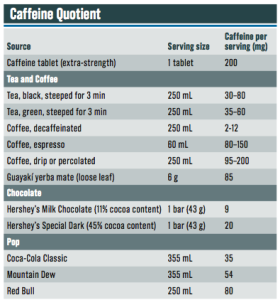Is caffeine a legal performance enhancer?

Find out how to use the legal (but still enhancing) stimulant to your benefit
It’s so powerful, it should be banned. In fact, caffeine was restricted under World Anti-Doping Agency (wada) rules until 2004 because it was such a clear and effective athletic performance-booster. But those rules were tricky to enforce because caffeine shows up in so much of what we eat and drink – chocolate, coffee, teas, mate and so on – so it was eventually dropped from the wada list. These days, athletes have free rein to use this strong stimulant as they please.
With that in mind, the International Society of Sports Nutrition (issn) released a position statement in January 2013 detailing just how, when and why you might want to add a little buzz to your beverage. Caffeine interferes with how adenosine, a calming brain chemical that slows nerve activity, binds to its receptors. Caffeine thereby increases nerve activity, notably upping adrenaline. This has far-reaching effects – from hormones and metabolism to cardiovascular and respiratory changes. Its most powerful effects may be in the mind: studies have found that caffeine alters the sensation of perceived intensity. By making your effort feel easier, it allows you to push harder for longer, improving your running endurance and advancing your strength training.
But before you down the rest of that coffee pot, you need to figure out how, and even if, caffeine works for you. Some people experience little benefit from caffeine, while others are quite sensitive and feel increased anxiety, headaches, dizziness and difficulty sleeping even from relatively modest doses. These side effects also occur when regular users have too much. So if just one cup of coffee makes you jittery, think twice about adding it to your pre-race routine.
For those who want to use caffeine safely and effectively, issn offers some helpful advice:
Dosage: Caffeine is most effective for trained athletes consuming a low-to-moderate dose of three to six milligrams per kilogram body weight. Beyond this level, you risk uncomfortable side effects like racing heart, the jitters and an overactive bowel. Above nine milligrams per kilogram, there are no further benefits: more is definitely not better.
Source: The form of caffeine matters. Caffeine is bound by organic complexes within different plants that affect how well you absorb the molecule. How you prepare coffee or tea also changes how much caffeine is released – and the potency isn’t always predictable. The most consistent effects come from using the anhydrous form – the kind found in pills and energy drinks, where the caffeine has been isolated and purified.
The only way to find out how caffeine affects your own 10k is to experiment with it. Most studies use 3 to 6 mg per kilogram but effects on the nervous system start at 1 mg per kg. That’s a good place to start if you don’t consume caffeine regularly; otherwise, try 3 mg per kg. Start drinking your caffeine (or swallowing the pill) about an hour before the start of the event. Levels in your blood will stay elevated for three to four hours. For runs lasting longer than three hours, you can split your dose and take the second half mid-run. Alternately, take smaller doses every half hour – the effects are the same.
One common myth you don’t have to worry about is that caffeine’s diuretic effects will leave you dehydrated. Studies have found no evidence that caffeine changes your fluid balance in a way that would hurt performance. All that peeing before a race? It’s just nerves, not your java.
By Bobbi Barbarich




